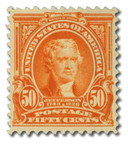
U.S. #310
Series of 1902-03 50¢ Jefferson
Issue Date: March 23, 1903
Quantity issued: 2,651,774 (estimate)
Printed by: Bureau of Engraving and Printing
Method: Flat plate
Watermark: Double line
Perforation: 12
Color: Orange
The Series of 1902-03 50¢ stamp pictures Thomas Jefferson, a Founding Father and our nation’s third President. Businesses had called for a stamp with a denomination between 15¢ and 50¢, but were denied. U.S. #310 was used most often in blocks of four on packages destined to Chile or Bolivia. These examples are scarce and are even more desirable than mint blocks of four, which are only slightly more plentiful.
Jefferson’s Legacy
Thomas Jefferson was the principal author of the Declaration of Independence and one of our nation’s most influential Founding Fathers. Under his administration, the United States acquired the Louisiana Purchase, doubling the size of our country. Jefferson was also a “polymath” – a genius on many levels.
The first President to be inaugurated in Washington, Thomas Jefferson was also the first to live in the so-called “President’s House.” Only partially built when he moved in, Jefferson helped design the east and west terraces and the north portico of what was later to become the White House.
President John F. Kennedy welcomed a group of 49 Nobel Prize winners to the White House by saying, “I think this is the most extraordinary collection of talent and of human knowledge that has ever been gathered together at the White House – with the possible exception of when Thomas Jefferson dined alone.” Although he excelled in several academic fields, Jefferson’s legacy is his eloquent – often passionate – expression of democratic ideals.
“We hold these truths to be self-evident, that all men are created equal, that they are endowed by their Creator with certain unalienable Rights, that among these are Life, Liberty, and the pursuit of Happiness. That to secure these rights, Governments are instituted among Men, deriving their just powers from the consent of the governed.” – excerpt from the Declaration of Independence
Series of 1902-03
In 1902, the Postmaster General commissioned an entirely new series of general issues. Until this time, the current regular issues had been in use since 1890 with relatively few changes.
The ornate new designs, however, were not the only addition to the 1902 series. The 13-cent denomination was added, and two new faces were introduced – Benjamin Harrison and Admiral David Farragut. For the first time in postal history, an American woman was honored.
A slight change was also made in the format. Each stamp in this series bears the inscription, “Series 1902.” This caused some concern abroad, as many European philatelists wondered whether the U.S. was planning on issuing new stamps each year. Many of the stamps, however, did not even reach post offices until 1903, and the next general issues were not produced until 1908.















